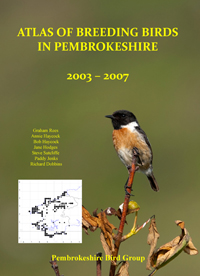Oystercatcher - 1994
 Thursday, December 15, 2011 at 5:53PM
Thursday, December 15, 2011 at 5:53PM Breeding resident and passage migrant
Mathew (1894) mentions breeding at only three coastal sites, the "Bishop Rock", Skomer and "on an island at the entrance to Milford Haven". If this was a true reflection of the Oystercatcher's breeding status at that time, it had increased considerably by 1949 when Lockley et al. estimated that 120 pairs bred around the mainland coast and noted that it bred on all the islands. They reported that 36 pairs nested at Skomer in 1946 and over 50 pairs on Skokholm in 1947 and 1948. The range remains the same today (see map) and a total of about 300 pairs breed in Pembrokeshire, with about 150 pairs on the islands of Skokholm and Skomer, where recent breeding success has been low due to an increase in predation by gulls.
Ringing has shown that some young birds move out of Pembrokeshire after the breeding season, to winter on the western European seaboard as far south as Spain. Older birds tend to winter nearer home, on the Cleddau Estuary and as far as the Burry Inlet in West Glamorgan. Winter numbers are augmented by immigrants, as an Oystercatcher marked with a wing-tag has illustrated. This bird bred near Aberdeen in 1986 and had moved to the Gann by September of that year, having been seen on route at Belfast Lough in August. It wintered at the Gann and continued to commute between Scotland and Wales until at least 1989.
Numbers build up in Pembrokeshire during July and August, when flocks are seen passing south off Strumble Head and as demonstrated by counts from the Cleddau Estuary (see Table 6), where peak numbers are reached between September and November. Numbers decrease slowly thereafter with a more rapid departure of most of the winter birds during March and April.
Smaller winter concentrations are found on the Teifi (50-80 birds) and Nevern (30-60) estuaries and at Fishguard Harbour (40-50) when Oystercatchers also use the outer coast: a survey in the winter of 1985 found 928 birds were present, thus the midwinter population for the whole county runs to about 1400 birds.
Oystercatchers are heard passing over the county at night during arrival and departure periods but the only diurnal inland record is of a single bird at Llysyfran reservoir on 13 March 1983.

Fieldwork 1984-88 (based on 478 tetrads)
Red = breeding confirmed = 50
Orange = breeding probable = 14
Yellow = breeding possible = 23
Total tetrads in which registered = 87 (18.2%)
 1994 BoP in
1994 BoP in  Oystercatcher
Oystercatcher 

Reader Comments